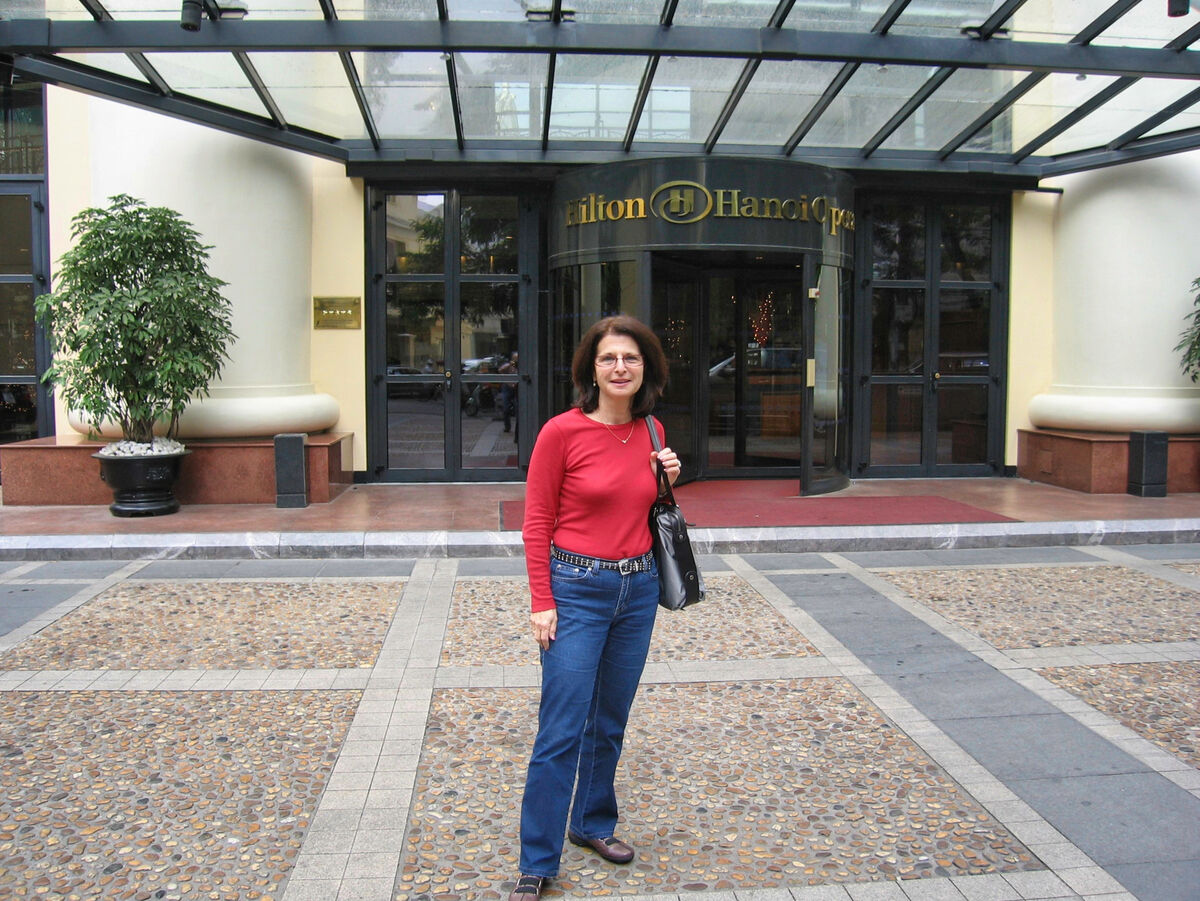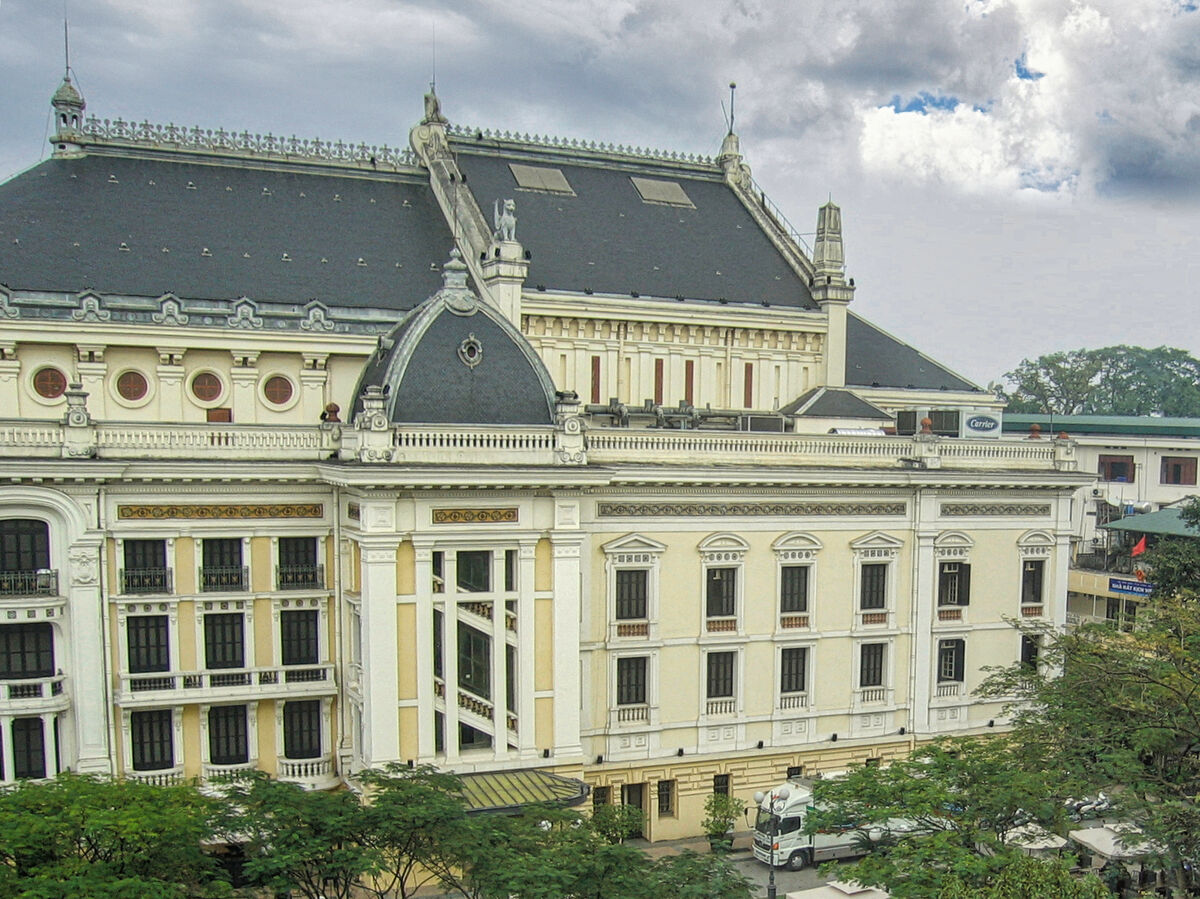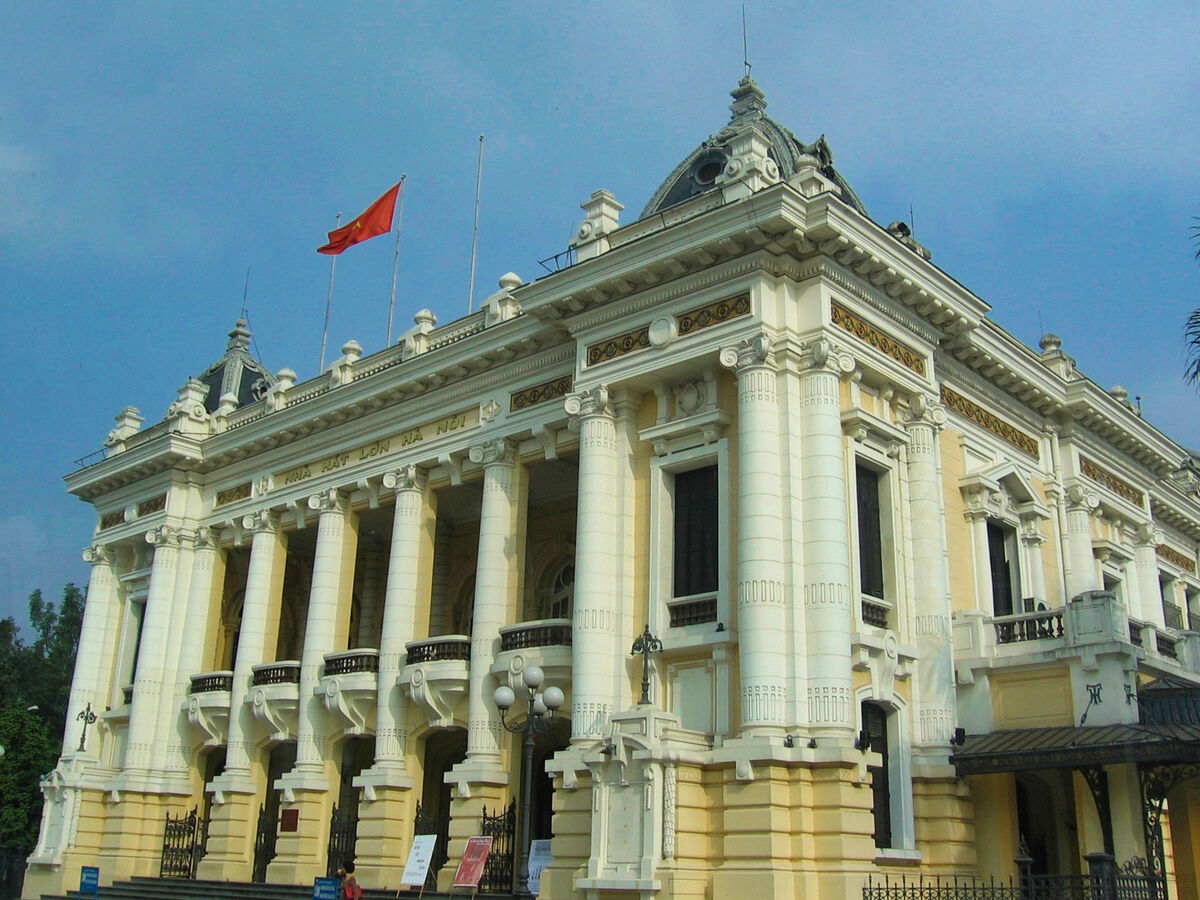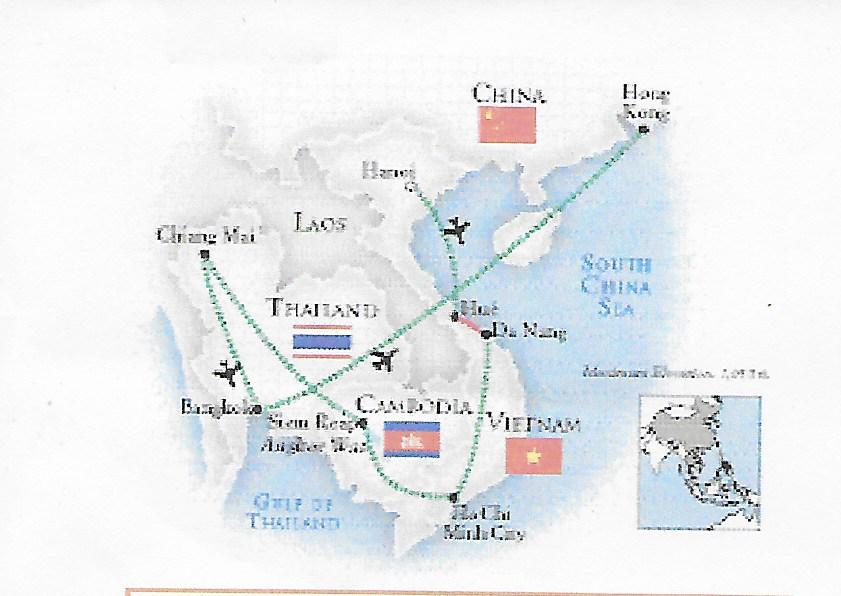Vietnam: Hanoi Street Scenes
Aug 19, 2022 14:47:20 #
We took our first Tauck Tour to Vietnam, Cambodia, Thialand and Hong Kong in December 2007, a year after I retired and I'll post re-processed images from that trip over the next several weeks. All were taken with a Canon Powershot SX-60 point and shoot camera. Our first stop was Hanoi.
Hanoi (UK: /(ˌ)hæ-, həˈnɔɪ/ ha-, hə-NOY or US: /hɑː-/ hah-NOY; Vietnamese: Hà Nội [haː˨˩ noj˧˨ʔ] (listen)) is the capital city of Vietnam. It covers an area of 3,359.82 km2 (1,297.2 sq mi). The second largest city in Vietnam, it consists of 12 urban districts, one district-leveled town and 17 rural districts. Located within the Red River Delta, Hanoi is the cultural and political centre of Vietnam.
Hanoi traced its history back to the third century BCE, when a portion of the modern-day city served as the capital of the historic Vietnamese nation of Âu Lạc. Following the collapse of Âu Lạc, the city was part of Han China. In 1010, Vietnamese emperor Lý Thái Tổ established the capital of the imperial Vietnamese nation Đại Việt in modern-day central Hanoi, naming the city Thăng Long (literally "Ascending Dragon"). Thăng Long remained Đại Việt's political centre until 1802, when the Nguyễn dynasty, the last imperial Vietnamese dynasty, moved the capital to Huế. The city was renamed Hanoi in 1831, and served as the capital of French Indochina from 1902 to 1945. On 6 January 1946, the National Assembly of the Democratic Republic of Vietnam designated Hanoi as the capital of the newly-independent country, which would last during the First Indochina War (1946–1954) and the Vietnam War (1955–1975). Hanoi has been the capital of the Socialist Republic of Vietnam since 1976.
Hanoi hosts various venerable educational institutions and cultural venues of significance, including the Vietnam National University, the Mỹ Đình National Stadium, and the Vietnam National Museum of Fine Arts. Amongst its achievements, it has a UNESCO World Heritage Site—The Central Sector of the Imperial Citadel of Thăng Long, first constructed in 1011AD. Hanoi was the only Asia-Pacific locality to be granted the "City for Peace" title by the UNESCO on 16 July 1999, recognizing its contributions to the struggle for peace, its efforts to promote equality in the community, protect the environment, promote culture and education, and care for younger generations. Hanoi joined UNESCO's Network of Creative Cities as a Design City on 31 October 2019, on the occasion of World Cities' Day. The city has also hosted numerous international events, including APEC Vietnam 2006, 132nd Assembly of the Inter-Parliamentary Union (IPU-132), 2019 North Korea–United States Hanoi Summit, as well as the 2003 Southeast Asian Games, 2009 Asian Indoor Games, and the 2021 Southeast Asian Games.
The history of Hanoi is long and complicated so I'll include only some salient points from Wikipedia omitting the ancient history.
Hanoi under Independent Vietnam
In 1010, Lý Thái Tổ, the first ruler of the Lý dynasty, moved the capital of Đại Việt to the site of the Đại La Citadel. Claiming to have seen a dragon ascending the Red River, he renamed the site Thăng Long (昇龍, "Soaring Dragon") – a name still used poetically to this day. Thăng Long remained the capital of Đại Việt until 1397, when it was moved to Thanh Hóa, then known as Tây Đô (西都), the "Western Capital". Thăng Long then became Đông Đô (東都), the "Eastern Capital".
n 1408, the Chinese Ming dynasty attacked and occupied Vietnam, changing Đông Đô's name to Dongguan (Chinese: 東關, Eastern Gateway), or Đông Quan in Sino-Vietnamese. In 1428, the Vietnamese overthrew the Chinese under the leadership of Lê Lợi, who later founded the Lê dynasty and renamed Đông Quan Đông Kinh (東京, "Eastern Capital") or Tonkin. During 17th century, the population of Đông Kinh was estimated by Western diplomats as about 100,000. Right after the end of the Tây Sơn dynasty, it was named Bắc Thành (北城, "Northern Citadel").
During Nguyễn dynasty and the French colonial period
When the Nguyễn dynasty was established in 1802, Gia Long moved the capital to Huế. Thăng Long was no longer the capital, its Hán tự was changed from 昇龍 ("Rising dragon") to 昇隆 ("Ascent and prosperity"), aiming to reduce the sentiment of Lê dynasty. Emperors of Vietnam usually used dragon (龍 long) as a symbol of their imperial strength and power. In 1831, the Nguyễn emperor Minh Mạng renamed it Hà Nội (河內, "Between Rivers" or "River Interior"). Hanoi was occupied by the French in 1873 and passed to them ten years later. As Hanoï, it was located in the protectorate of Tonkin became the capital of French Indochina after 1887.
During WWII and Vietnam War
Coat of arms of Hanoi under French Indochina and State of Vietnam.
The city was occupied by the Imperial Japanese in 1940 and liberated in 1945, when it briefly became the seat of the Việt Minh government after Ho Chi Minh proclaimed the independence of Vietnam. However, the French returned and reoccupied the city in 1946. After nine years of fighting between the French and Viet Minh forces, Hanoi became the capital of an independent North Vietnam in 1954. The French Army withdrew that year and the People's Army of Vietnam and International Control Commission occupied the city under the terms of the 1954 Geneva Conference.
During the Vietnam War, Hanoi's transportation facilities were disrupted by the bombing of bridges and railways by the U.S. Seventh Air Force and Republic of Vietnam Air Force. These were all, however, later repaired. Following the end of the war, Hanoi became the capital of a reunified Vietnam when North and South Vietnam were reunited on 2 July 1976.
Modern Hanoi
After the Đổi Mới economic policies were approved in 1986, the Communist Party and national and municipal governments hoped to attract international investments for urban development projects in Hanoi. The high-rise commercial buildings did not begin to appear until ten years later due to the international investment community being skeptical of the security of their investments in Vietnam. Rapid urban development and rising costs displaced many residential areas in central Hanoi. Following a short period of economic stagnation after the 1997 Asian financial crisis, Hanoi resumed its rapid economic growth.
On 29 May 2008, it was decided that Hà Tây Province, Vĩnh Phúc Province's Mê Linh District and four communes of Lương Sơn District, Hòa Bình Province be merged into the metropolitan area of Hanoi from 1 August 2008. Hanoi's total area then increased to 334,470 hectares in 29 subdivisions with the new population being 6,232,940., effectively tripling its size. The Hanoi Capital Region (Vùng Thủ đô Hà Nội), a metropolitan area covering Hanoi and six surrounding provinces under its administration, will have an area of 13,436 square kilometres (5,188 sq mi) with 15 million people by 2020.
Hanoi has experienced a rapid construction boom recently. Skyscrapers, appearig in new urban areas, have dramatically changed the cityscape and have formed a modern skyline outside the old city. In 2015, Hanoi is ranked 39th by Emporis in the list of world cities with most skyscrapers over 100 m; its two tallest buildings are Hanoi Landmark 72 Tower (336 m, second tallest in Vietnam after Ho Chi Minh City's Landmark 81 and third tallest in south-east Asia after Malaysia's Petronas Towers) and Hanoi Lotte Center (272 m, also, third tallest in Vietnam).
Public outcry in opposition to the redevelopment of culturally significant areas in Hanoi persuaded the national government to implement a low-rise policy surrounding Hoàn Kiếm Lake. The Ba Đình District is also protected from commercial redevelopment.
Tourism
According to Mastercard’s 2019 report, Hanoi is Vietnam's most visited city (15th in Asia Pacific), with 4.8 million overnight international visitors in 2018. Hanoi is sometimes dubbed the "Paris of the East" for its French influences. With its tree-fringed boulevards, more than two dozen lakes and thousands of French colonial-era buildings, Hanoi is a popular tourist destination.
The tourist destinations in Hanoi are generally grouped into two main areas: the Old Quarter and the French Quarter(s). The "Old Quarter" is in the northern half of Hoàn Kiếm District with small street blocks and alleys, and a traditional Vietnamese atmosphere. Many streets in the Old Quarter have names signifying the goods ("hàng") the local merchants were or are specialized in. For example, "Hàng Bạc" (silver stores) still have many stores specializing in trading silver and jewelries.
Two areas are generally called the "French Quarters": the governmental area in Ba Đình District and the south of Hoàn Kiếm District. Both areas have distinctive French Colonial style villas and broad tree-lined avenues.
The political center of Vietnam, Ba Đình has a high concentration of Vietnamese government headquarters, including the Presidential Palace, the National Assembly Building, and several ministries and embassies, most of which used administrative buildings of colonial French Indochina. The One Pillar Pagoda, the Lycée du Protectorat and the Ho Chi Minh Mausoleum are also in Ba Dinh.
South of Hoàn Kiếm's "French Quarter" has several French-Colonial landmarks, including the Hanoi Opera House, the Sofitel Legend Metropole Hanoi hotel, the National Museum of Vietnamese History (formerly the École française d'Extrême-Orient), and the St. Joseph's Cathedral. Most of the French-Colonial buildings in Hoan Kiem are now used as foreign embassies.
Since 2014, Hanoi has consistently been voted in the world's top ten destinations by TripAdvisor. It ranked 8th in 2014, 4th in 2015 and 8th in 2016. Hanoi is the most affordable international destination in TripAdvisor's annual TripIndex report. In 2017, Hanoi will welcome more than 5 million international tourists.
https://en.wikipedia.org/wiki/Hanoi
I hope you enjoy this first of many sets!
Mark
Hanoi (UK: /(ˌ)hæ-, həˈnɔɪ/ ha-, hə-NOY or US: /hɑː-/ hah-NOY; Vietnamese: Hà Nội [haː˨˩ noj˧˨ʔ] (listen)) is the capital city of Vietnam. It covers an area of 3,359.82 km2 (1,297.2 sq mi). The second largest city in Vietnam, it consists of 12 urban districts, one district-leveled town and 17 rural districts. Located within the Red River Delta, Hanoi is the cultural and political centre of Vietnam.
Hanoi traced its history back to the third century BCE, when a portion of the modern-day city served as the capital of the historic Vietnamese nation of Âu Lạc. Following the collapse of Âu Lạc, the city was part of Han China. In 1010, Vietnamese emperor Lý Thái Tổ established the capital of the imperial Vietnamese nation Đại Việt in modern-day central Hanoi, naming the city Thăng Long (literally "Ascending Dragon"). Thăng Long remained Đại Việt's political centre until 1802, when the Nguyễn dynasty, the last imperial Vietnamese dynasty, moved the capital to Huế. The city was renamed Hanoi in 1831, and served as the capital of French Indochina from 1902 to 1945. On 6 January 1946, the National Assembly of the Democratic Republic of Vietnam designated Hanoi as the capital of the newly-independent country, which would last during the First Indochina War (1946–1954) and the Vietnam War (1955–1975). Hanoi has been the capital of the Socialist Republic of Vietnam since 1976.
Hanoi hosts various venerable educational institutions and cultural venues of significance, including the Vietnam National University, the Mỹ Đình National Stadium, and the Vietnam National Museum of Fine Arts. Amongst its achievements, it has a UNESCO World Heritage Site—The Central Sector of the Imperial Citadel of Thăng Long, first constructed in 1011AD. Hanoi was the only Asia-Pacific locality to be granted the "City for Peace" title by the UNESCO on 16 July 1999, recognizing its contributions to the struggle for peace, its efforts to promote equality in the community, protect the environment, promote culture and education, and care for younger generations. Hanoi joined UNESCO's Network of Creative Cities as a Design City on 31 October 2019, on the occasion of World Cities' Day. The city has also hosted numerous international events, including APEC Vietnam 2006, 132nd Assembly of the Inter-Parliamentary Union (IPU-132), 2019 North Korea–United States Hanoi Summit, as well as the 2003 Southeast Asian Games, 2009 Asian Indoor Games, and the 2021 Southeast Asian Games.
The history of Hanoi is long and complicated so I'll include only some salient points from Wikipedia omitting the ancient history.
Hanoi under Independent Vietnam
In 1010, Lý Thái Tổ, the first ruler of the Lý dynasty, moved the capital of Đại Việt to the site of the Đại La Citadel. Claiming to have seen a dragon ascending the Red River, he renamed the site Thăng Long (昇龍, "Soaring Dragon") – a name still used poetically to this day. Thăng Long remained the capital of Đại Việt until 1397, when it was moved to Thanh Hóa, then known as Tây Đô (西都), the "Western Capital". Thăng Long then became Đông Đô (東都), the "Eastern Capital".
n 1408, the Chinese Ming dynasty attacked and occupied Vietnam, changing Đông Đô's name to Dongguan (Chinese: 東關, Eastern Gateway), or Đông Quan in Sino-Vietnamese. In 1428, the Vietnamese overthrew the Chinese under the leadership of Lê Lợi, who later founded the Lê dynasty and renamed Đông Quan Đông Kinh (東京, "Eastern Capital") or Tonkin. During 17th century, the population of Đông Kinh was estimated by Western diplomats as about 100,000. Right after the end of the Tây Sơn dynasty, it was named Bắc Thành (北城, "Northern Citadel").
During Nguyễn dynasty and the French colonial period
When the Nguyễn dynasty was established in 1802, Gia Long moved the capital to Huế. Thăng Long was no longer the capital, its Hán tự was changed from 昇龍 ("Rising dragon") to 昇隆 ("Ascent and prosperity"), aiming to reduce the sentiment of Lê dynasty. Emperors of Vietnam usually used dragon (龍 long) as a symbol of their imperial strength and power. In 1831, the Nguyễn emperor Minh Mạng renamed it Hà Nội (河內, "Between Rivers" or "River Interior"). Hanoi was occupied by the French in 1873 and passed to them ten years later. As Hanoï, it was located in the protectorate of Tonkin became the capital of French Indochina after 1887.
During WWII and Vietnam War
Coat of arms of Hanoi under French Indochina and State of Vietnam.
The city was occupied by the Imperial Japanese in 1940 and liberated in 1945, when it briefly became the seat of the Việt Minh government after Ho Chi Minh proclaimed the independence of Vietnam. However, the French returned and reoccupied the city in 1946. After nine years of fighting between the French and Viet Minh forces, Hanoi became the capital of an independent North Vietnam in 1954. The French Army withdrew that year and the People's Army of Vietnam and International Control Commission occupied the city under the terms of the 1954 Geneva Conference.
During the Vietnam War, Hanoi's transportation facilities were disrupted by the bombing of bridges and railways by the U.S. Seventh Air Force and Republic of Vietnam Air Force. These were all, however, later repaired. Following the end of the war, Hanoi became the capital of a reunified Vietnam when North and South Vietnam were reunited on 2 July 1976.
Modern Hanoi
After the Đổi Mới economic policies were approved in 1986, the Communist Party and national and municipal governments hoped to attract international investments for urban development projects in Hanoi. The high-rise commercial buildings did not begin to appear until ten years later due to the international investment community being skeptical of the security of their investments in Vietnam. Rapid urban development and rising costs displaced many residential areas in central Hanoi. Following a short period of economic stagnation after the 1997 Asian financial crisis, Hanoi resumed its rapid economic growth.
On 29 May 2008, it was decided that Hà Tây Province, Vĩnh Phúc Province's Mê Linh District and four communes of Lương Sơn District, Hòa Bình Province be merged into the metropolitan area of Hanoi from 1 August 2008. Hanoi's total area then increased to 334,470 hectares in 29 subdivisions with the new population being 6,232,940., effectively tripling its size. The Hanoi Capital Region (Vùng Thủ đô Hà Nội), a metropolitan area covering Hanoi and six surrounding provinces under its administration, will have an area of 13,436 square kilometres (5,188 sq mi) with 15 million people by 2020.
Hanoi has experienced a rapid construction boom recently. Skyscrapers, appearig in new urban areas, have dramatically changed the cityscape and have formed a modern skyline outside the old city. In 2015, Hanoi is ranked 39th by Emporis in the list of world cities with most skyscrapers over 100 m; its two tallest buildings are Hanoi Landmark 72 Tower (336 m, second tallest in Vietnam after Ho Chi Minh City's Landmark 81 and third tallest in south-east Asia after Malaysia's Petronas Towers) and Hanoi Lotte Center (272 m, also, third tallest in Vietnam).
Public outcry in opposition to the redevelopment of culturally significant areas in Hanoi persuaded the national government to implement a low-rise policy surrounding Hoàn Kiếm Lake. The Ba Đình District is also protected from commercial redevelopment.
Tourism
According to Mastercard’s 2019 report, Hanoi is Vietnam's most visited city (15th in Asia Pacific), with 4.8 million overnight international visitors in 2018. Hanoi is sometimes dubbed the "Paris of the East" for its French influences. With its tree-fringed boulevards, more than two dozen lakes and thousands of French colonial-era buildings, Hanoi is a popular tourist destination.
The tourist destinations in Hanoi are generally grouped into two main areas: the Old Quarter and the French Quarter(s). The "Old Quarter" is in the northern half of Hoàn Kiếm District with small street blocks and alleys, and a traditional Vietnamese atmosphere. Many streets in the Old Quarter have names signifying the goods ("hàng") the local merchants were or are specialized in. For example, "Hàng Bạc" (silver stores) still have many stores specializing in trading silver and jewelries.
Two areas are generally called the "French Quarters": the governmental area in Ba Đình District and the south of Hoàn Kiếm District. Both areas have distinctive French Colonial style villas and broad tree-lined avenues.
The political center of Vietnam, Ba Đình has a high concentration of Vietnamese government headquarters, including the Presidential Palace, the National Assembly Building, and several ministries and embassies, most of which used administrative buildings of colonial French Indochina. The One Pillar Pagoda, the Lycée du Protectorat and the Ho Chi Minh Mausoleum are also in Ba Dinh.
South of Hoàn Kiếm's "French Quarter" has several French-Colonial landmarks, including the Hanoi Opera House, the Sofitel Legend Metropole Hanoi hotel, the National Museum of Vietnamese History (formerly the École française d'Extrême-Orient), and the St. Joseph's Cathedral. Most of the French-Colonial buildings in Hoan Kiem are now used as foreign embassies.
Since 2014, Hanoi has consistently been voted in the world's top ten destinations by TripAdvisor. It ranked 8th in 2014, 4th in 2015 and 8th in 2016. Hanoi is the most affordable international destination in TripAdvisor's annual TripIndex report. In 2017, Hanoi will welcome more than 5 million international tourists.
https://en.wikipedia.org/wiki/Hanoi
I hope you enjoy this first of many sets!
Mark
She looks well rested after sleeping through most of the flight across the Pacific

(Download)
Hanoi Opera House taken from our hotel room

(Download)

(Download)
Hanoi Opera House taken from the tour bus

(Download)

(Download)

(Download)

(Download)

(Download)

(Download)

(Download)
Aug 19, 2022 14:49:23 #
Aug 19, 2022 15:32:36 #
Aug 19, 2022 15:39:49 #
Aug 19, 2022 15:58:10 #
srfmhg wrote:
Trip Itinerary: I apologize for the poor resolution of the map
Great set of images!!! Mark
Aug 19, 2022 16:20:43 #
Aug 19, 2022 16:21:28 #
Aug 19, 2022 16:33:38 #
Thank you Mark for an impressive set of pictures. They show a vastly changed Hanoi from when I first visited it in the 1980s. There was really only one hotel at which you could stay, and in that one too visiting the toilet could be an olfactory nightmare. One was recommended to confine oneself to two eating places – – something with a street address of 202 (the place did not have a name) and another one called the "Piano Bar" (there was someone banging on a piano during dinner). I managed to restart the World Bank's lending to the country after the Vietnamese had accounted for the US's missing in action.
Your photograph of your wife in front of the Hilton recalled something that happened on my first visit. The governor of the central bank of Vietnam was driving me around to show me the city: "this is such and such palace," "this is that and that lake," this is the whatever pagoda," and similar stuff. We went past a rather large building when the governor said quickly "And this is the Hanoi Hilton." I said "you mean the prison in which American flyers were incarcerated?" "Yes," the governor replied, "but we don't like to dwell on the past." It is good to see from your photograph that Hanoi has acquired a genuine Hilton.
Your photograph of your wife in front of the Hilton recalled something that happened on my first visit. The governor of the central bank of Vietnam was driving me around to show me the city: "this is such and such palace," "this is that and that lake," this is the whatever pagoda," and similar stuff. We went past a rather large building when the governor said quickly "And this is the Hanoi Hilton." I said "you mean the prison in which American flyers were incarcerated?" "Yes," the governor replied, "but we don't like to dwell on the past." It is good to see from your photograph that Hanoi has acquired a genuine Hilton.
Aug 19, 2022 16:35:40 #
Aug 19, 2022 17:10:48 #
Aug 19, 2022 17:16:10 #
Aug 19, 2022 18:13:02 #
ELNikkor wrote:
Love the photos and history, thanks for sharing!
Thanks very much EL. My pleasure!
Aug 19, 2022 18:14:11 #
josquin1 wrote:
How about the street that has a train ambling down the middle of it?
Thanks Josquin. I have one of those from a different town. Missed it in Hanoi.
Aug 19, 2022 18:14:38 #
Aug 19, 2022 18:14:58 #
If you want to reply, then register here. Registration is free and your account is created instantly, so you can post right away.







